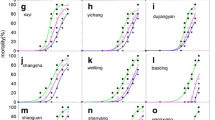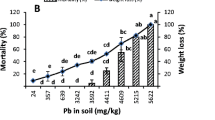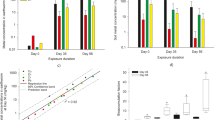Abstract
Cadmium (Cd) is of great concern in the soil environment and it can damage terrestrial organisms. The purpose of this study was to employ a toxicokinetic/toxicodynamic (TK/TD) approach to investigate the effects of toxicologically relevant Cd accumulation on the life cycle growth of earthworms (Lumbricus rubellus and Eisenia fetida) and to assess potential terrestrial ecosystem risk. We reanalyzed growth toxicity and whole body and pellet accumulation data linked with TK/TD and life cycle growth models to estimate key rate constants. The growth risk of earthworms exposed to Cd was also assessed. This study found that the estimated whole body killing rate constant (0.114 g d μg−1) was much lower than that of pellet (0.248 g d μg−1). The recovery rate constant for whole body (6.02 d−1) was much higher than that of pellet (2.91 d−1). We also employed a life cycle-based probabilistic risk assessment model to estimate the growth inhibition risk for earthworms in response to environmentally relevant concentrations of Cd in Taiwan. Results showed that earthworms had a 90% growth inhibition probability risk of body weight, which was lower than 872.33 mg based on assessment of toxicologically relevant Cd accumulation. This study suggests that toxicologically relevant Cd accumulation could accurately reflect the capacity of Cd toxicity to earthworms. The integrated life cycle toxicity of earthworms exposed to Cd in this study provides a robust and applicable tool for the management of ecological risk assessment of Cd-contaminated soil.






Similar content being viewed by others
References
Agrawal A, Gopal K (2013) Biomonitoring of water and waste water. Springer, New York
Alunno-Bruscia M, van der Veer HW, Kooijman SALM (2009) The AquaDEB project (phase I): analyzing the physiological flexibility of aquatic species and connecting physiological diversity to ecological and evolutionary processes by using dynamic energy budgets. J Sea Res 62:43–48
Ardestani MM, van Gestel CAM (2013) Using a toxicokinetics approach to explain the effect of soil pH on cadmium bioavailability to Folsomia candida. Environ Pollut 180:122–130
Ardestani MM, van Straalen NM, van Gestel CAM (2014) Uptake and elimination kinetics of metals in soil invertebrates: a review. Environ Pollut 193:277–295
Asensio V, Kille P, Morgan AJ, Soto M, Marigomez I (2007) Metallothionein expression and neutral uptake as biomarkers of metal exposure and effect in Eisenia fetida and Lumbricus terrestris exposed to Cd. Eur J Soil Sci Biol 43:S233–S238
Ashauer R, Boxall ABA, Brown CD (2007) New ecotoxicological model to simulate survival of aquatic invertebrates after exposure of fluctuating and sequential pulses of pesticides. Environ Sci Technol 41:1480–1486
Blakemore RJ, Chang CH, Chuang SC, Ito MT, James S, Chen JH (2006) Biodiversity of earthworms in Taiwan: a species checklist with confirmation and new records of exotic lumbricids Eisenia fetida and Eiseniella tetraedra. Taiwania 51:226–236
Bohlen PJ (2016) Earthworms. In: Lal R (ed) Encyclopedia of soil science, 3rd edn. CRC Press, New York
Conder JM, Seals LD, Lanno RP (2002) Methods for determing toxicologically relevant cadmium residues in the earthworm Eisenia fetisa. Chemosphere 4:1–7
Dubois M, Hare L (2009) Subcellular distribution of cadmium in two aquatic invertebrates: change over time and relationship to Cd assimilation and loss by predatory insect. Environ Sci Technol 43:356–361
Giska I, van Gestel CAM, Skip B, Laskowski R (2014) Toxicokinetics of metal in the earthworm Lumbricus rubellus exposed to natural polluted soils-relevance of laboratory tests to the field situation. Environ Pollut 190:123–132
Gong L, Li W, Li J, Li WE, Wu WR, Yu LW (2015) Cloning, characterization, and expression of cadmium-induced metallothionein-2 gene from earthworm Pheretima aspergillum (E. Perrier). Genet Mol Res 14:16782–16789
Gruber C, Stürzenbaum S, Gehrig P, Sack R, Hunziker P, Berger B, Dallinger R (2000) Isolation and characterization of a self-sufficient on-domain protein (Cd)-metallothionein from Eisenia foetida. Eur J Biochem 267:573–582
Haeba M, Kuta J, Arhouma ZK, Elwerfalli HMA (2013) Earthworm as bioindicator of soil pollution around Benghazi City, Libya. J Environ Anal Toxicol 3:1000189
Hendriks AJ, Heikens A (2001) The power of size 2. Rate constants and equilibrium ratios for accumulation of organic substance related to octanol-water partition ratio and species weight. Environ Toxicol Chem 20:1421–1437
Hendriks AJ, van der Linde A, Cornelissen G, Sijm DTHM (2001) The power of size 1. Rate constants and equilibrium ratio and species weight. Environl Toxicol Chem 20:1399–1420
Ibekwe AM, Papiernik SK, Gan J, Yate SR, Yang CH, Crowley DE (2001) Impact of fumigants on soil microbial communities. Appl Environ Microbiol 67:3245–3257
Kammenga JE, Busschers M, Van Straalen NM, Jepson PC, Bakker J (1996) Stress induced fitness reduction is not determined by the most sensitive life-cycle trait. Funct Ecol 10:106–111
Kooijman SALM, Bedaux JJM (1996) The analysis of aquatic toxicity data. VU University Press, Amsterdam
Lee JH, Landrum PF, Koh CH (2002) Prediction of time-dependent PAH toxicity in Hyalella Azteca using a damage assessment model. Environ Sci Technol 36:3124–3130
Li L, Zhou D, Wang P, Peijnenburg WJGM (2009a) Kinetics of cadmium uptake and subcellular partitioning in the earthworm Eisenia fetida exposed to cadmium-contaminated soil. Arch Environ Contam Toxicol 57:718–724
Li LZ, Zhou DM, Luo XS, Wang P, Wang QY (2008) Effect of major cations and pH on the acute toxicity of cadmium to the earthworm Eisenia fetida: implications for the biotic ligand model approach. Arch Environ Contam Toxicol 55:70–77
Li LZ, Zhou DM, Wang P, Allen H, Sauvé S (2009c) Predicting Cd partitioning in spiked soils and bioaccumulation in the earthworm Eisenia fetida. Appl Soil Ecol 42:118–123
Li LZ, Zhou DM, Wang P, Jin SY, Peijnenburg WJGM, Rienecke AJ, van Gestel CAM (2009b) Effect of cation competition on cadmium uptake from solution by earthworm Eisenia fetida. Environ Toxicol Chem 28:1732–1738
Liang SH, Chen MH, Chen CC, Chen CS, Chen JH, Chen SC (2009) Impact of cadmium on bacterial communities in the gut of Metaphire posthuma. J Hazard Mater 172:1212–1217
Liang SH, Chen SC, Chen CY, Kao CM, Yang JI, Shieh BS, Chen JH, Chen CC (2011) Cadmium-induced earthworm metallothionein-2 is associated with metal accumulation and counteracts oxidative stress. Pedobiologia 54:333–340
Liao CM, Lin CM, Jou LJ, Chang KC (2007) Linking valve closure behavior and sodium transport mechanism in freshwater clam Corbicula fluminea in response to copper. Environ Pollut 147:656–667
Menzie CA, Ziccardi LM, Lowney YW, Fairbrother A, Shock SS, Tsuji JS, Hamai D, Proctor D, Henry E, Su SH, Kierski MW, McArdle ME, Yost LJ (2009) Importance of considering the framework principles in risk assessment for metals. Environ Sci Technol 43:8478–8482
Morgan JE, Morgan AJ (1988) Earthworms as biological monitors of cadmium, copper, lead and zinc in metalliferous soils. Environ Pollut 54:123–138
Nahmani J, Hodson ME, Black S (2007) Effects of metals on life cycle parameters of earthworm Eisenia fetida exposed to field-contaminated, metal-polluted soils. Environ Pollut 149:44–58
Nahmani J, Hodson ME, Devin S, Vijver MJ (2009) Uptake kinetics of metals by the earthworm Eisenia fetida exposed to field-contaminated soil. Environ Pollut 157:2622–2628
Nakashima T, Okada T, Asahi J, Yamashita A, Kawai K, kasai H, Matsuno K, Gamou S, Hirano T (2008) 8-Hydroxydeoxyguanosine generated in the earthworm Eisenia fetida grown in metal-containing soil. Mutat Res 654:138–144
Ngu TT, Sturzenbaum SR, Stilloman MJ (2006) Cadmium binding studies to the earthworm Lumbricus rubellus metallothionein by electrospray mass spectrometry and circular dichroism spectroscopy. Biochem Biophys Res Commun 351:229–233
Paoletti MG (1999) The role of earthworms for assessment of sustainability and as bioindicators. Agric Ecosyst Environ 74:137–155
Peijnenburg WJGM, Baerselman R, de Groot AC, Jager T, Posthuma L, Van Veen RPM (1999) Relating environmental availability to bioavailability: soiltype-dependent metal accumulation in the Oligochaete Eisenia andrei. Ecotoxicol Environ Safe 44:294–310
Pirooznia M, Gong P, Guan X, Inouye LS, Yang K, Perkins EJ, Deng Y (2007) Cloning, analysis and functional annotation of expressed sequence tags from the earthworm Eisenia fetida. BMC Bioinform 8(Suppl. 7):S7
Ramskov T, Forbes VE (2008) Life history and population dynamics of the opportunistic polychaete Capitella sp. I in relation to sediment organic matter. Mar Ecol Prog Ser 69:181–192
Rizwan M, Ali S, Adrees M, Rizvi H, Zia-Ur-Rehman M, Hannan F, Qayyum MF, Hafeez F, Ok YS (2016) Cadmium stress in rice: toxic effects, tolerance mechanisms, and management: a critical review. Environ Sci Pollut Res Int 23:17859–17879
Spurgeon DJ, Svendsen C, Kille P, Morgan AJ, Weeks JM (2004) Responses of earthworm (Lumbricus rubellus) to copper and cadmium as determined by measurement of juvenile traits in a specifically designed test system. Ecotoxicol Environ Safe 57:54–64
Stürzenbaum SR, Kille P, Morgan AJ (1998) Heavy metal-induced molecular responses in the earthwarm Lumbricus rubellus genetic fingerprinting by directed differential display. Appl Soil Ecol 9:495–500
Stürzenbaum SR, Georgiev O, Morgan AJ, Kille P (2004) Cadmium detoxification in earthworms: from genes to cells. Environ Sci Technol 38:6283–6289
Taiwan EPA (2011) https://sgw.epa.gov.tw/public/07_Pollutant.asp?polluMethod=Soil
Tsai JW, Liao CM (2006) Mode of action and growth toxicity of arsenic to tilapia Oreochromis mossambicus can be determined bioenergetically. Arch Environ Contam Toxicol 50:144–152
US EPA (2007) Framework for metals risk assessment. US Environmental Protection Agency Office of the Science Advisor, Risk Assessment Forum
Veltman K, Huijbregts MA, Hendriks AJ (2008) Cadmium bioaccumulation factors for terrestrial species: application of the mechanistic bioaccumulation model OMEGA to explain field data. Sci Total Environ 406:413–418
Veltman K, Huijbregts MAJ, Hendriks AJ (2010) Integration of biotic ligand models (BLM) and bioaccumulation kinetics into a mechanistic framework for metal uptake in aquatic organisms. Environ Sci Technol 44:5022–5028
Wang XS, Qin Y (2007) Some characteristics of the distribution of heavy metals in urban topsoil of Xuzhou, China. Environ Geochem Health 29:11–19
West GB, Brown JH, Enquist BJ (2001) A general model for ontogenetic growth. Nature 413:628–631
Wuana RA, Okieimen FE (2011) Heavy metals in contaminated soil: a review of sources, chemistry, risks and best available strategies for remediation. ISRN Ecol 2011:402647
Žaltauskaitė J, Sodienė I (2014) Effects of cadmium and lead on the life-cycle parameters of juvenile earthworm Eisenia fetida. Ecotoxicol Environ Safe 103:9–16
Author information
Authors and Affiliations
Corresponding author
Ethics declarations
Conflict of interest
The authors declare that they have no conflict of interest.
Rights and permissions
About this article
Cite this article
Chen, WY., Li, WH., Ju, YR. et al. Life cycle toxicity assessment of earthworms exposed to cadmium-contaminated soils. Ecotoxicology 26, 360–369 (2017). https://doi.org/10.1007/s10646-017-1769-4
Accepted:
Published:
Issue Date:
DOI: https://doi.org/10.1007/s10646-017-1769-4




